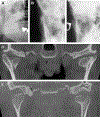Temporomandibular Joint Disorders and Orofacial Pain
- PMID: 26614951
- PMCID: PMC6762033
- DOI: 10.1016/j.cden.2015.08.004
Temporomandibular Joint Disorders and Orofacial Pain
Abstract
Temporomandibular disorders (TMD) affect 5% to 12% of the United States population. This article discusses common conditions related to temporomandibular joints, including disc displacements, inflammatory disturbances, loose joint bodies, traumatic disturbances, and developmental conditions. Also addressed are the appropriate imaging modalities and diagnostic criteria for TMD.
Keywords: Condylar fracture; Condylar hyperplasia and hypoplasia; DC/TMD; Degenerative joint disease; Diagnostic criteria; Orofacial pain; Synovial chondromatosis; TMJ.
Copyright © 2016 Elsevier Inc. All rights reserved.
Figures









References
-
- Schiffman E, Ohrbach R, Truelove E, et al. Diagnostic criteria for temporomandibular disorders (DC/TMD) for clinical and research applications: recommendations of the International RDC/TMD Consortium Network* and orofacial pain special interest group†. J Oral Facial Pain Headache 2014;28(1):6–27. - PMC - PubMed
-
- Hunter A, Kalathingal S. Diagnostic imaging for temporomandibular disorders and orofacial pain. Dent Clin North Am 2013;57(3):405–18. - PubMed
Publication types
MeSH terms
Grants and funding
LinkOut - more resources
Full Text Sources
Other Literature Sources
Medical

